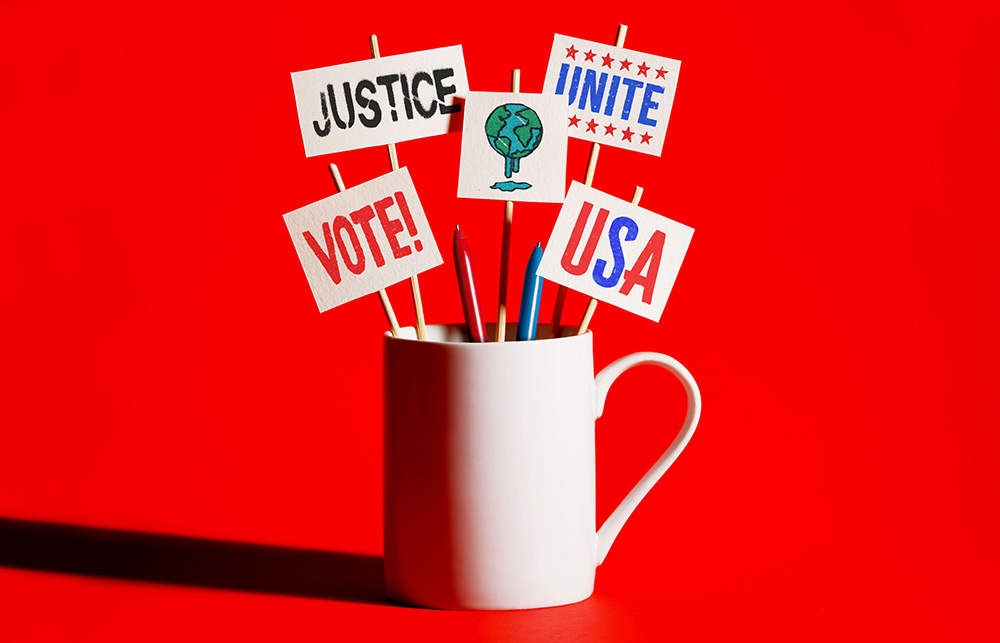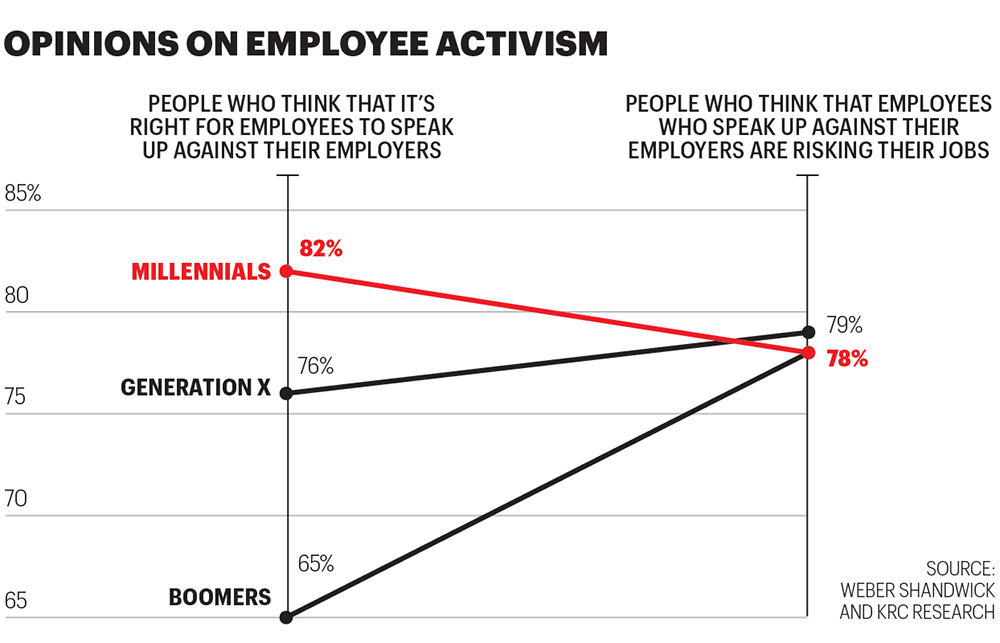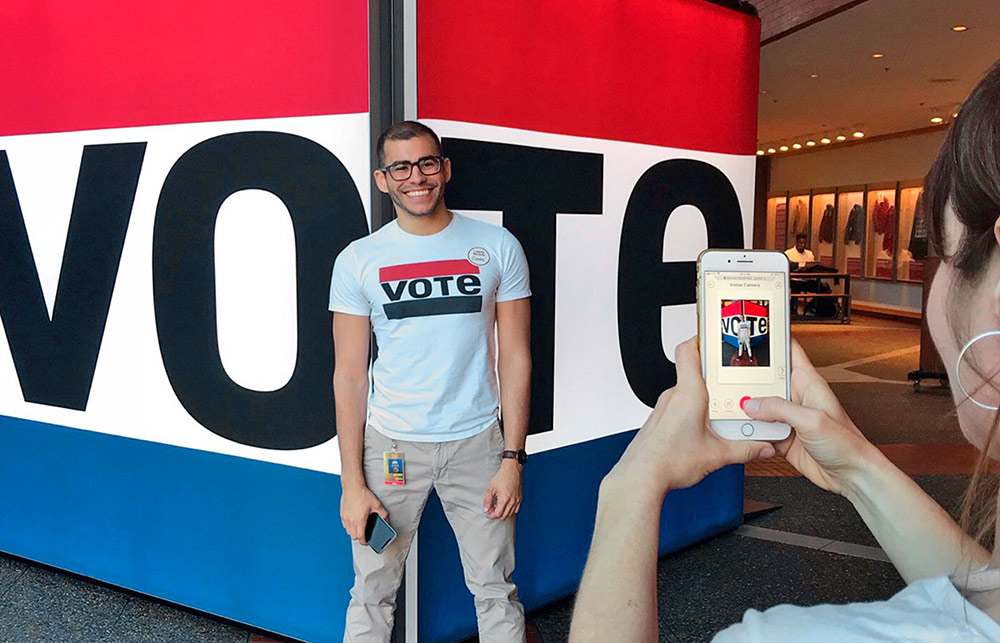
随着美国总统大选的临近,此前不断升温的员工维权浪潮似乎有了缓和的迹象。不过,别以为美国雇主和员工已经亲如一家。尽管在疫情期间,高调的罢工和抗议活动声势渐弱,但是新的分歧正在酝酿,带来的风险也更高。此次大选的结果也将对这波浪潮产生重大影响。
规模最大的几场员工抗议活动让很多人感到震惊。去年,约有3000名亚马逊公司员工为反对公司的气候政策而罢工,数百名Wayfair员工也为了抗议公司向美国移民拘留中心出售家具而罢工。2018年,约有2万名谷歌员工上街游行,抗议公司向一名被控存在不当性行为的高管支付高额离职金。员工因为与薪资、福利或工作条件无关的问题展开如此大规模的抗议活动,这是史无前例的。工作场所出现了新的变化。
今年到目前为止,暂时性的因素让维权活动有所平息。毕竟,当所有员工都居家办公的时候,人们很难组织起引人瞩目的罢工行动。此外,激烈的社会维权活动,也即全美范围内针对种族不平等和警察暴力执法而掀起的大规模抗议活动,在很大程度上也让员工针对个别公司的抗议显得无足轻重。

至少就目前而言,数百家公司也找到了一种受欢迎的方式,将员工维权与企业目标结合起来。这些公司为鼓励员工投票而出台了奖励措施,并为投票提供便利。员工和雇主可能会因为在双方都认为对国家有益的事情上进行合作而松一口气。
不过,在双方为新的关系拟定条款之际,这样的友好关系只是暂时的。“员工维权已经常态化了。”最近刚离开万博宣伟公关公司的莱斯莉•盖恩斯-罗斯如是说道。此前,她在该公司研究了14年的企业声誉,最近还研究了员工维权活动。“现在,人们可以在社会和政治问题上站队了。首席执行官、体育教练、诺贝尔奖得主……所有人都开始站队。这已经司空见惯了。”
尽管如此,站队是一回事,举着标语牌上街谴责雇主那些并不会影响自己薪水或安全的行为又是另一回事。南加州大学最近研究发现,大多数公司都没有为这种令人困惑的行为做好准备。在一项针对公司公关部主管的调查中,多数受访者表示其公司不存在针对员工维权活动的政策,大多数人甚至不知道自己的公司是否支持员工参与维权活动。
如今的员工维权活动在一定程度上能够用千禧一代的心理来解释,对他们来说,这种看似怪异的行为一点儿也不奇怪。据万博宣伟2019年的一项研究表明,千禧一代和他们的长辈都知道,抗议可能会让他们面临被解雇的风险。他们只是不在乎而已。

这是因为,一般而言,千禧一代比前几代人更看重为一家具有崇高使命、被认为对社会产生积极影响的公司工作。德勤的一项研究发现,有80%的千禧一代表示,他们在这样的公司工作会更有动力。而因为许多人都认同这种观点,供职于这些公司可以让他们在同龄人中享有较高的地位。
结果,特别是对千禧一代来说(以及对越来越多不同年龄段的工人来说),雇主在其他领域的行为也属于员工工作条件的一部分。雇主的行为并不是无关紧要的,工人们会为了这些事而举行罢工。
帮助工人罢工的组织,也就是工会已经注意到了这一现象。美国劳工联合会和产业工会联合会(简称劳联-产联)的财务主管伊丽莎白•舒勒指出,维权员工“看到了集体行动的价值。集体行动让他们的声音更加有力”。而在今年4月,亚马逊公司的“亚马逊员工气候正义组织”举办在线会议时,与会的重要发言人之一就是美国劳工部门最有影响力的人:美国劳联-产联主席理查德•特拉姆卡。
亚马逊和谷歌罢工活动的组织者均与各个工会的官员有过协商(暂不清楚哪一方是主动的),并与其他员工就可能成立工会的事宜进行了商议。谷歌高管已经与咨询公司IRI Consultants的工作人员会面,IRI和其他许多公司一样负责为客户提供咨询,防止客户公司的员工成立工会。谷歌还以违反公司政策为由解雇了部分维权人士(以员工呼吁成立工会为由而将其解雇是违法的)。
亚马逊公司也解雇了一批维权员工,但该公司的首席执行官杰夫•贝佐斯在今年5月的公司年会上解释说:“我们支持每位员工批评雇主工作条件的权利,但这并不意味着他们可以不遵守内部政策。”
几乎完全不存在工会组织的科技巨头绝不是唯一出现维权员工的公司,只不过它们面临的问题是最突出的。对这些公司而言,员工维权活动尤其可能演变成关于建立工会的斗争。美国劳联-产联的财务主管舒勒说:“科技行业是劳工运动的下一个前沿阵地。”今年1月,美国通讯工人工会发起了“组织数字员工运动”,其最初的目标是电子游戏制造商。
老牌的工会也不一定可以确保运动能够获得成功。如果拜登在今年11月赢得大选,工会的地位将得到极大巩固,尽管如此,许多科技公司员工和千禧一代仍然对工会持有怀疑态度。在他们看来,工会是旧时代遗留下产物。耐克、巴塔哥尼亚等成功的公司已经拥抱了员工维权活动,甚至还成了活动引领者,目的是使公司受益。不过可以肯定的是,员工维权活动还将继续发酵,令人不安地揭露企业经营过程中会遭遇的严酷现实。

这个大选年出现了一个奇特的现象:对于那些准备在今年11月参与投票的员工,有超过900家公司将为他们照发工资,其中也有许多公司愿意为参加投票站工作的员工照发工资。推动这一进程的是“Time to Vote”倡议,这是一家由李维斯、巴塔哥尼亚、PayPal等大型公司于2018年成立、由企业提供资助的超党派非营利组织。在今年一触即发的政治背景下,其无可争议的宗旨引发了多方共鸣。它也缓解了新冠疫情带来的问题:许多投票站工作人员年龄较大,他们不应该花一整天的时间与成千上万的陌生人接触。“Time to Vote”原本的目标是在年内招募25万名投票站工作人员,不过截至9月初,它已经招募到了35万人。(财富中文网)
本文另一版本登载于《财富》杂志2020年10月刊。
翻译:智竑
随着美国总统大选的临近,此前不断升温的员工维权浪潮似乎有了缓和的迹象。不过,别以为美国雇主和员工已经亲如一家。尽管在疫情期间,高调的罢工和抗议活动声势渐弱,但是新的分歧正在酝酿,带来的风险也更高。此次大选的结果也将对这波浪潮产生重大影响。
规模最大的几场员工抗议活动让很多人感到震惊。去年,约有3000名亚马逊公司员工为反对公司的气候政策而罢工,数百名Wayfair员工也为了抗议公司向美国移民拘留中心出售家具而罢工。2018年,约有2万名谷歌员工上街游行,抗议公司向一名被控存在不当性行为的高管支付高额离职金。员工因为与薪资、福利或工作条件无关的问题展开如此大规模的抗议活动,这是史无前例的。工作场所出现了新的变化。
今年到目前为止,暂时性的因素让维权活动有所平息。毕竟,当所有员工都居家办公的时候,人们很难组织起引人瞩目的罢工行动。此外,激烈的社会维权活动,也即全美范围内针对种族不平等和警察暴力执法而掀起的大规模抗议活动,在很大程度上也让员工针对个别公司的抗议显得无足轻重。
2018年11月1日,谷歌员工因为反对性骚扰而在纽约开展罢工。
至少就目前而言,数百家公司也找到了一种受欢迎的方式,将员工维权与企业目标结合起来。这些公司为鼓励员工投票而出台了奖励措施,并为投票提供便利。员工和雇主可能会因为在双方都认为对国家有益的事情上进行合作而松一口气。
不过,在双方为新的关系拟定条款之际,这样的友好关系只是暂时的。“员工维权已经常态化了。”最近刚离开万博宣伟公关公司的莱斯莉•盖恩斯-罗斯如是说道。此前,她在该公司研究了14年的企业声誉,最近还研究了员工维权活动。“现在,人们可以在社会和政治问题上站队了。首席执行官、体育教练、诺贝尔奖得主……所有人都开始站队。这已经司空见惯了。”
尽管如此,站队是一回事,举着标语牌上街谴责雇主那些并不会影响自己薪水或安全的行为又是另一回事。南加州大学最近研究发现,大多数公司都没有为这种令人困惑的行为做好准备。在一项针对公司公关部主管的调查中,多数受访者表示其公司不存在针对员工维权活动的政策,大多数人甚至不知道自己的公司是否支持员工参与维权活动。
如今的员工维权活动在一定程度上能够用千禧一代的心理来解释,对他们来说,这种看似怪异的行为一点儿也不奇怪。据万博宣伟2019年的一项研究表明,千禧一代和他们的长辈都知道,抗议可能会让他们面临被解雇的风险。他们只是不在乎而已。
人们对员工维权的看法。
数据来源:万博宣伟公司和开锐咨询公司
这是因为,一般而言,千禧一代比前几代人更看重为一家具有崇高使命、被认为对社会产生积极影响的公司工作。德勤的一项研究发现,有80%的千禧一代表示,他们在这样的公司工作会更有动力。而因为许多人都认同这种观点,供职于这些公司可以让他们在同龄人中享有较高的地位。
结果,特别是对千禧一代来说(以及对越来越多不同年龄段的工人来说),雇主在其他领域的行为也属于员工工作条件的一部分。雇主的行为并不是无关紧要的,工人们会为了这些事而举行罢工。
帮助工人罢工的组织,也就是工会已经注意到了这一现象。美国劳工联合会和产业工会联合会(简称劳联-产联)的财务主管伊丽莎白•舒勒指出,维权员工“看到了集体行动的价值。集体行动让他们的声音更加有力”。而在今年4月,亚马逊公司的“亚马逊员工气候正义组织”举办在线会议时,与会的重要发言人之一就是美国劳工部门最有影响力的人:美国劳联-产联主席理查德•特拉姆卡。
亚马逊和谷歌罢工活动的组织者均与各个工会的官员有过协商(暂不清楚哪一方是主动的),并与其他员工就可能成立工会的事宜进行了商议。谷歌高管已经与咨询公司IRI Consultants的工作人员会面,IRI和其他许多公司一样负责为客户提供咨询,防止客户公司的员工成立工会。谷歌还以违反公司政策为由解雇了部分维权人士(以员工呼吁成立工会为由而将其解雇是违法的)。
亚马逊公司也解雇了一批维权员工,但该公司的首席执行官杰夫•贝佐斯在今年5月的公司年会上解释说:“我们支持每位员工批评雇主工作条件的权利,但这并不意味着他们可以不遵守内部政策。”
几乎完全不存在工会组织的科技巨头绝不是唯一出现维权员工的公司,只不过它们面临的问题是最突出的。对这些公司而言,员工维权活动尤其可能演变成关于建立工会的斗争。美国劳联-产联的财务主管舒勒说:“科技行业是劳工运动的下一个前沿阵地。”今年1月,美国通讯工人工会发起了“组织数字员工运动”,其最初的目标是电子游戏制造商。
老牌的工会也不一定可以确保运动能够获得成功。如果拜登在今年11月赢得大选,工会的地位将得到极大巩固,尽管如此,许多科技公司员工和千禧一代仍然对工会持有怀疑态度。在他们看来,工会是旧时代遗留下产物。耐克、巴塔哥尼亚等成功的公司已经拥抱了员工维权活动,甚至还成了活动引领者,目的是使公司受益。不过可以肯定的是,员工维权活动还将继续发酵,令人不安地揭露企业经营过程中会遭遇的严酷现实。
“Time to Vote”倡议呼吁雇主为那些在选举日参与投票和参加志愿服务的员工照发工资。这一倡议对投票站工作人员的招募产生了惊人的影响。
“Time to Vote”倡议呼吁雇主为那些在选举日参与投票和参加志愿服务的员工照发工资。
这一倡议对投票站工作人员的招募产生了惊人的影响。
这个大选年出现了一个奇特的现象:对于那些准备在今年11月参与投票的员工,有超过900家公司将为他们照发工资,其中也有许多公司愿意为参加投票站工作的员工照发工资。推动这一进程的是“Time to Vote”倡议,这是一家由李维斯、巴塔哥尼亚、PayPal等大型公司于2018年成立、由企业提供资助的超党派非营利组织。在今年一触即发的政治背景下,其无可争议的宗旨引发了多方共鸣。它也缓解了新冠疫情带来的问题:许多投票站工作人员年龄较大,他们不应该花一整天的时间与成千上万的陌生人接触。“Time to Vote”原本的目标是在年内招募25万名投票站工作人员,不过截至9月初,它已经招募到了35万人。(财富中文网)
本文另一版本登载于《财富》杂志2020年10月刊。
翻译:智竑
As the election approaches, the building trend of employee activism against employers seems to be taking a benign turn—but don’t imagine that America’s employers and workers are now united in peace and love. While high-profile employee walkouts and protests have faded in the pandemic era, a new kind of friction, with higher stakes, is on the way. The election’s outcome will strongly influence how it plays out.
The largest employee protests have shocked many. Last year some 3,000 Amazon employees walked out in opposition to the company’s climate policy, and hundreds of Wayfair workers walked out to protest the company’s sale of furniture to U.S. immigrant detention centers. In 2018 an estimated 20,000 Google employees marched to protest the company’s generous severance payment to an executive accused of sexual misconduct. Such large-scale employee revolts over issues unrelated to pay, benefits, or working conditions were unprecedented. Something truly new was happening in the workplace.
Temporary factors have tamped down the activism so far this year. It’s hard to organize attention-grabbing walkouts when everyone is working from home. In addition, intense social activism in the form of massive nationwide protests over racial inequities and police behavior have largely outweighed complaints against individual companies.
At least for the moment, hundreds of companies have also found a welcome way to unite employee activism with corporate purpose. They’re offering incentives for employees to vote and facilitate voting.Workers and employers are likely relieved to be collaborating on what they agree is good for the country.
Such amity is only a lull, however, as these two groups work out the terms of a new relationship. “Employee activism has become normalized,” says Leslie Gaines-Ross, who recently left the Weber Shandwick communications firm after 14 years there researching corporate reputation and, more recently, employee activism. “It’s now permissible to take sides on social and political issues. Everyone is taking sides—CEOs, coaches, Nobel Prize winners. It’s normal today.”
Still, it’s one thing to take sides, another to carry placards down the street denouncing your employer for behavior that doesn’t affect your paycheck or safety. Recent research from the University of Southern California finds that most companies aren’t prepared for such baffling behavior. In a survey of public relations executives, most said their companies have no policies on employee activism, and most don’t even know whether their companies support employee involvement in activist activities.
Today’s employee activism is explained in part by the psyche of millennials, for whom such seemingly bizarre behavior doesn’t seem bizarre at all. They’re just as aware as their elders that it risks getting them fired, says 2019 research from Weber Shandwick. They just don’t care as much.
The reason is that, on average, millennials much more than previous generations value working for a company with a noble mission, recognized for making a positive impact on society. Research from Deloitte finds that 80% of them say they’d be more motivated working for such a company. Because so many of them feel that way, working for one of those companies gives them prestige among their peers.
Result: For millennials especially—and increasingly for workers of all ages—an employer’s behavior in the larger world is part of the employee’s working conditions. It isn’t irrelevant. It’s the kind of thing for which workers go on strike.
That fact has been noticed by organizations that help workers go on strike, labor unions. Employee activists “see the value of collective action. It makes their voices more powerful,” says Elizabeth Shuler, secretary-treasurer of the AFL-CIO. When an Amazon activist group, Amazon Employees for Climate Justice, held an online conference in April, a key speaker was AFL-CIO president Richard Trumka, the most powerful person in U.S. labor.
Organizers of the walkouts at Amazon and Google have conferred with officials of various unions—which group initially approached the other is not clear—and have met with other employees about potentially unionizing. Google executives have met with IRI Consultants, one of the many firms that advise companies on how to prevent unionization, and the company fired some of the activists for violating corporate policies. (Firing someone for advocating unionization is illegal.)
Amazon has also fired employee activists, a move that CEO Jeff Bezos defended at the company’s annual meeting in May. “We support every employee’s right to criticize their employer’s working conditions,” he said, “but that also doesn’t mean that they’re allowed to not follow internal policies.”
The almost entirely nonunionized big tech firms are far from the only ones with activist employees, but they are the most prominent. For them especially, employee activism could evolve into a fight over unionization. “The tech industry is the next frontier for the labor movement,” says the AFL-CIO’s Shuler. In January the Communications Workers of America launched the Campaign to Organize Digital Employees (CODE). Its initial targets are the video game makers.
Success for the established unions is not assured. While a Biden victory in November would strengthen their position enormously, many tech workers and millennials are leery of unions as relics of a bygone age. And some successful companies—think of Nike and Patagonia—have embraced employee activism and even led it, to their benefit. What seems certain is that such activism will continue to grow, bumping up uncomfortably against the hard realities of running a business.
*****
Big business for the civic good
Time to Vote wants employers to pay their workers for time they spend voting and volunteering on Election Day. It’s had an astonishing effect on poll worker recruitment.
It’s a striking new phenomenon in this election year: More than 900 companies are offering to pay employees for the time they spend voting in November, and in many cases for staffing polling places. The catalyst is Time to Vote, a nonpartisan, business-backed nonprofit formed in 2018 by Levi Strauss, Patagonia, PayPal, and other major corporations. In this year’s combustible political atmosphere, its uncontroversial purpose has struck a chord. It also alleviates a COVID-19 problem: Many poll workers are elderly and shouldn’t spend a long day interacting with thousands of strangers. Time to Vote set a goal of recruiting 250,000 poll workers this year. By early September it had recruited 350,000.
A version of this article appears in the October 2020 issue of Fortune.






